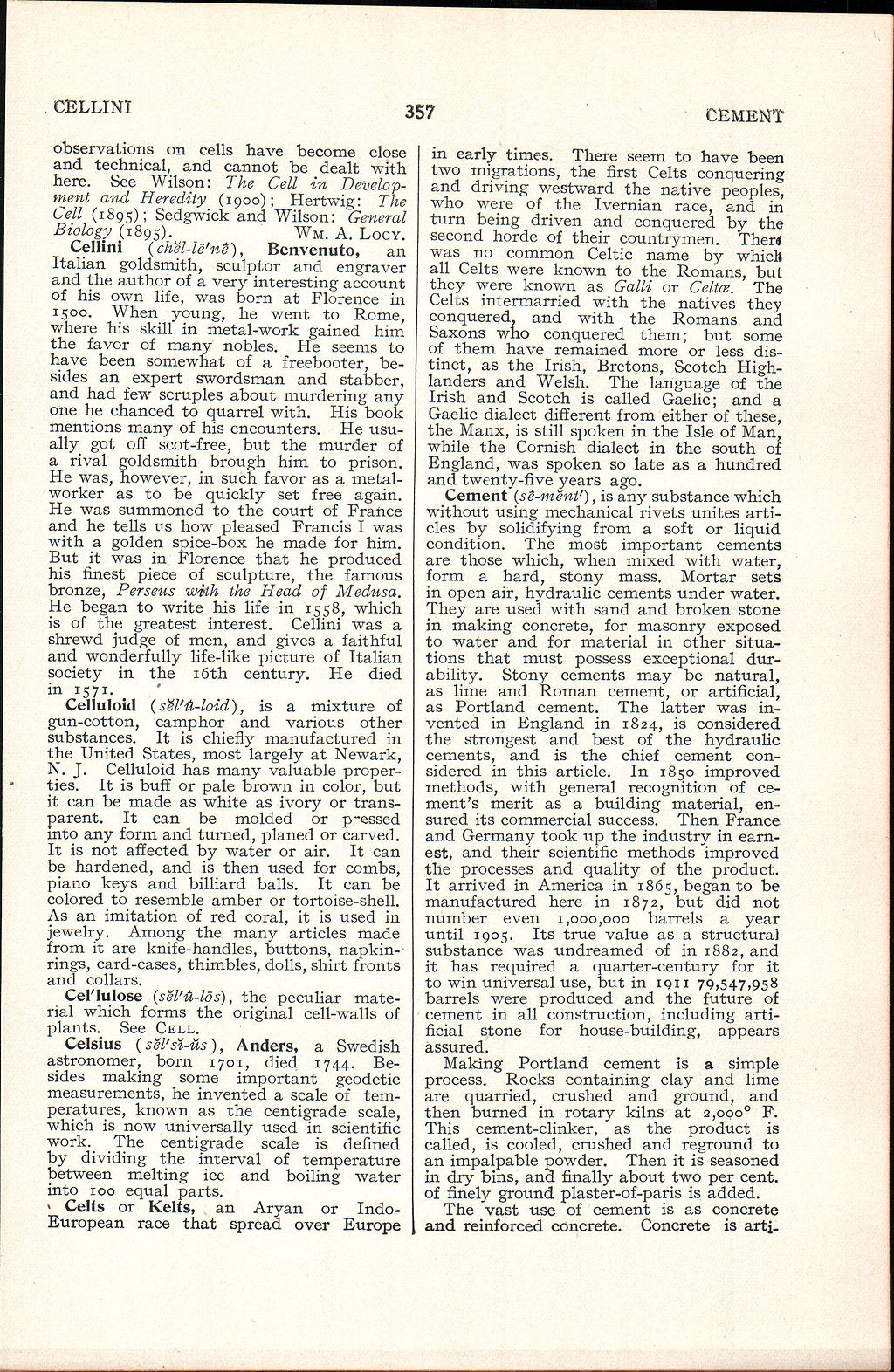observations on cells have become close and technical, and cannot be dealt with here. See Wilson: The Cell in Development and Heredity (1900); Hertwig: The Cell (1895); Sedgwick and Wilson: General Biology (1895).
Cellini (chĕl-lē′nē̇), Benvenuto, an Italian goldsmith, sculptor and engraver and the author of a very interesting account of his own life, was born at Florence in 1500. When young, he went to Rome, where his skill in metal-work gained him the favor of many nobles. He seems to have been somewhat of a freebooter, besides an expert swordsman and stabber, and had few scruples about murdering any one he chanced to quarrel with. His book mentions many of his encounters. He usually got off scot-free, but the murder of a rival goldsmith brought him to prison. He was, however, in such favor as a metal-worker as to be quickly set free again. He was summoned to the court of France and he tells us how pleased Francis I was with a golden spice-box he made for him. But it was in Florence that he produced his finest piece of sculpture, the famous bronze, Perseus with the Head of Medusa. He began to write his life in 1558, which is of the greatest interest. Cellini was a shrewd judge of men, and gives a faithful and wonderfully life-like picture of Italian society in the 16th century. He died in 1571.
Celluloid (sĕl′ū̇-loid), is a mixture of gun-cotton, camphor and various other substances. It is chiefly manufactured in the United States, most largely at Newark, N. J. Celluloid has many valuable properties. It is buff or pale brown in color, but it can be made as white as ivory or transparent. It can be molded or pressed into any form and turned, planed or carved. It is not affected by water or air. It can be hardened, and is then used for combs, piano keys and billiard balls. It can be colored to resemble amber or tortoise-shell. As an imitation of red coral, it is used in jewelry. Among the many articles made from it are knife-handles, buttons, napkin-rings, card-cases, thimbles, dolls, shirt fronts and collars.
Cel′lulose (sĕl′ū̇-lōs), the peculiar material which forms the original cell-walls of plants. See Cell.
Celsius (sĕl′sĭ-ŭs), Anders, a Swedish astronomer, born 1701, died 1744. Besides making some important geodetic measurements, he invented a scale of temperatures, known as the centigrade scale, which is now universally used in scientific work. The centigrade scale is defined by dividing the interval of temperature between melting ice and boiling water into 100 equal parts.
Celts or Kelts, an Aryan or Indo-European race that spread over Europe in early times. There seem to have been two migrations, the first Celts conquering and driving westward the native peoples, who were of the Ivernian race, and in turn being driven and conquered by the second horde of their countrymen. There was no common Celtic name by which all Celts were known to the Romans, but they were known as Galli or Celtæ. The Celts intermarried with the natives they conquered, and with the Romans and Saxons who conquered them; but some of them have remained more or less distinct, as the Irish, Bretons, Scotch Highlanders and Welsh. The language of the Irish and Scotch is called Gaelic; and a Gaelic dialect different from either of these, the Manx, is still spoken in the Isle of Man, while the Cornish dialect in the south of England, was spoken so late as a hundred and twenty-five years ago.
Cement (sē̇-mĕnt′), is any substance which without using mechanical rivets unites articles by solidifying from a soft or liquid condition. The most important cements are those which, when mixed with water, form a hard, stony mass. Mortar sets in open air, hydraulic cements under water. They are used with sand and broken stone in making concrete, for masonry exposed to water and for material in other situations that must possess exceptional durability. Stony cements may be natural, as lime and Roman cement, or artificial, as Portland cement. The latter was invented in England in 1824, is considered the strongest and best of the hydraulic cements, and is the chief cement considered in this article. In 1850 improved methods, with general recognition of cement's merit as a building material, ensured its commercial success. Then France and Germany took up the industry in earnest, and their scientific methods improved the processes and quality of the product. It arrived in America in 1865, began to be manufactured here in 1872, but did not number even 1,000,000 barrels a year until 1905. Its true value as a structural substance was undreamed of in 1882, and it has required a quarter-century for it to win universal use, but in 1911 79,547,958 barrels were produced and the future of cement in all construction, including artificial stone for house-building, appears assured.
Making Portland cement is a simple process. Rocks containing clay and lime are quarried, crushed and ground, and then burned in rotary kilns at 2,000° F. This cement-clinker, as the product is called, is cooled, crushed and reground to an impalpable powder. Then it is seasoned in dry bins, and finally about two per cent. of finely ground plaster-of-paris is added.
The vast use of cement is as concrete and reinforced concrete. Concrete is arti-
